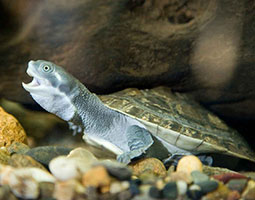Emydura macquarii signata
Description

The Brisbane River Turtle (Emydura macquarii signata) is a short-necked turtle native to the Brisbane River. It has an olive to brown carapace (shell) which can grow up to 28 centimetres. Underneath they are white or yellowish, they have a smooth head and a yellow stripe on the side of their face.
They are found in permanent slow flowing streams, large ponds or lagoons. As these bodies of water are often high in nutrients the turtles develop a mat of algae on their backs. This does not harm them and helps with camouflage.
Brisbane River Turtles mate in the water during spring. The female then buries up to 15 eggs in the river bank where they will incubate for up to 54 days before hatching.
Adaptations
- Australian turtles fold their head and neck sideways beneath their shell for protection
- They often bask in groups to increase the chance of spotting predators
- They have claws that help to dig in the ground for nesting and to forage for food
- They can move quickly over land to migrate between water bodies
Feeding relationships
- What I eat: Small crustaceans, insects, algae and aquatic plants
- What eats me: When young I am eaten by large freshwater fish, various wading birds, water rats and eagles. People are my biggest threat as an adult
Interesting facts
Freshwater turtles were a common food source for the Aboriginal people. These turtles were taken from the water, or dug up from their burrows when seasonal wetlands dry up.